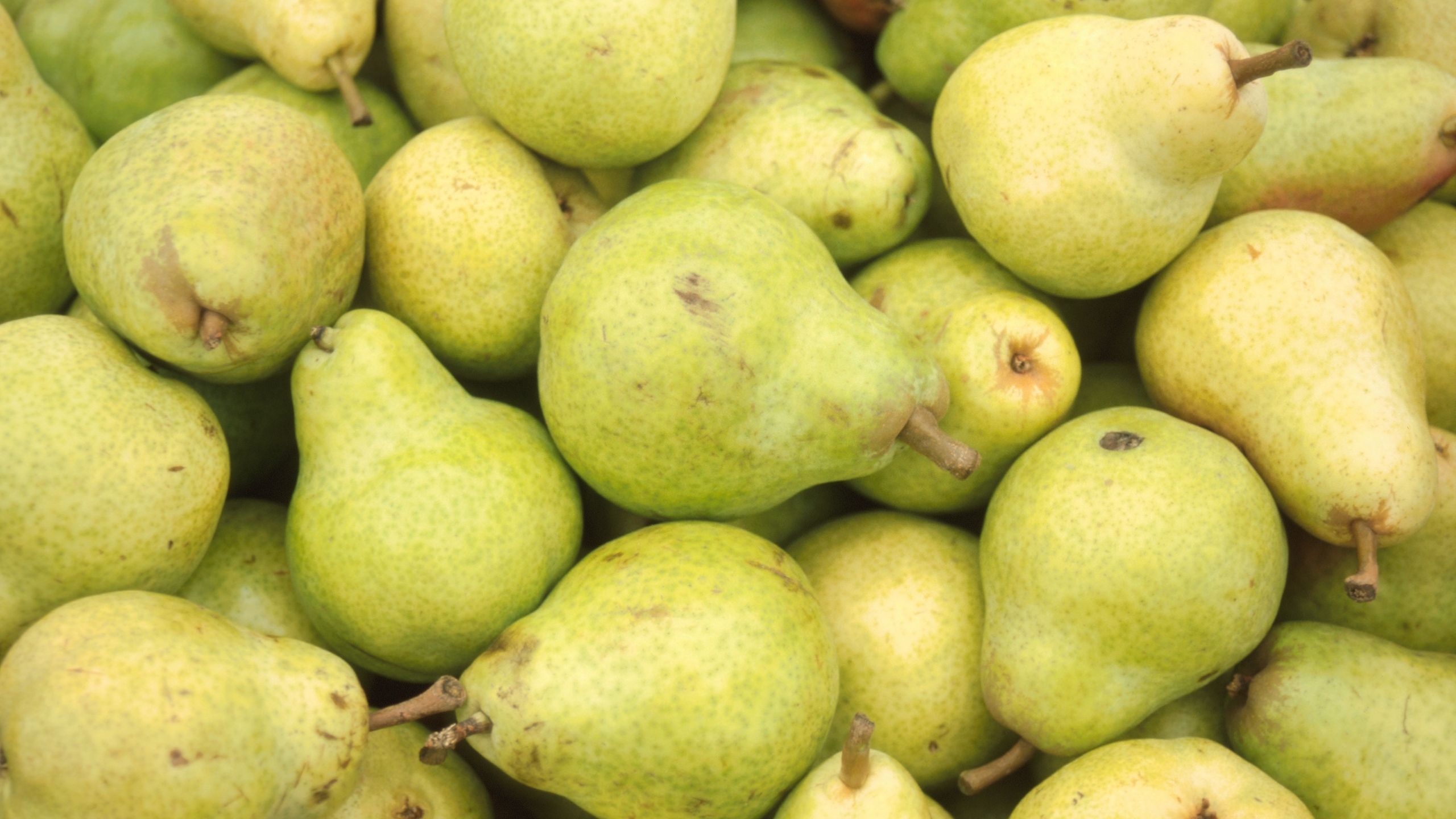Fruit Pests: Plum
The Backyard Orchardist
January 2020
Marion Murray, Extension IPM Specialist • Diane Alston, Extension Entomologist (No longer at USU)
DISEASES
(Listed in Order of Importance)
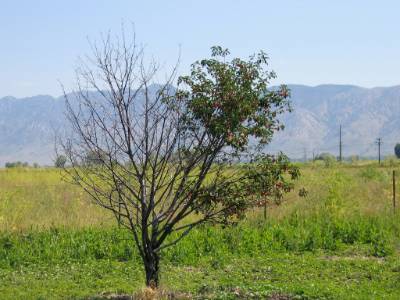
Crown Rot and Root Rot
Importance as a Pest on Plum: low-moderate
Other Fruit Hosts: all fruit trees
General Info: Caused by a soil-borne, fungus-like organism (Phytophthora), crown and root rot occurs worldwide on almost all fruit trees. This pathogen is present in most soils, but only causes infection under optimal circumstances—high soil moisture or standing water, and susceptible host tissue. Once trees are infected, there is no cure.
Symptoms:
- Slow growth
- Sparse, yellowing foliage
- Small fruit
- Wilting in hot weather
- Sudden plant death
- Dieback
- Can be confirmed by using a knife to expose the inner bark of the root collar. Look for dead brown tissue (infected) in contrast to cream-colored tissue (healthy).
Management: Plant only in well-drained areas. Do not replant in areas where root or crown rot occurred previously. Phosphorus acid (Agri-fos, for example) can help protect healthy trees growing next to infected trees, as this disease can spread by root-to-root contact.
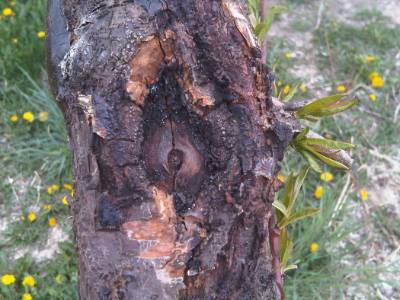
Perennial Canker
Importance as a Pest on Plum: low-moderate
Other Fruit Hosts: apricot, cherry, nectarine, and peach
General Info: Also called cytospora canker, perennial canker is caused by a fungus. Cankers are areas of dead cambium and bark, and occur on stems, limbs, or twigs. They are off-color, usually oval-shaped, and usually slightly sunken. Dark amber gum may exude from the canker edges. Cankers enlarge yearly or advance down side branches. Spores spread this fungus during wet weather, and successful infections occur in weak or wounded tissue.
Symptoms:
- Amber-colored gum
- Dead branches
- Loose bark
- To confirm, scrape bark to look for a distinct line of demarcation between diseased (brown) wood and healthy (cream colored) wood.
Management: Prevent wounding from winter sunscald by applying “white tree wrap” from December to April. Also, avoid injury to bark by cats, hedge trimmers, etc. And finally, control wood-boring insects since their damage may allow entrance of the fungus. Prune infected branches by cutting at least 4 inches below the visibly diseased wood (scrape away bark to find the edge of the canker).
INSECTS
(Listed in Order of Importance)

Greater Peachtree (Crown) Borer
Importance as a Pest on Plum: moderate
Other Fruit Hosts: apricot, nectarine, and peach
General Info: The adult is a clearwing moth that emerges in late June to lay eggs on the base of tree trunks and on exposed roots. The larvae tunnel in the cambium, just below the bark, typically at the soil-line of the trunk. Trees may be girdled and die due to borer injury. In spring, backyard orchardists should look carefully for oozing tree sap mixed with sawdust-like frass at the soil line.
Symptoms:
- Oozing sap at the soil line or upper roots
- Dieback in canopy
- Loose bark at soil line
- Insect pupal case left behind at moth emergence area (shown)
Management: Remove all weeds and tall grass from around the base of the trunk. Preventive trunk sprays (permethrin or carbaryl) is the main control tactic for conventional management. Apply once per month from early July through September, on the lower 12 -18” of trunk and exposed roots. Organic options include products containing spinosad (apply every 10 days), or the use of beneficial nematodes. (Contact your local county Extension agriculture agent for more information on the use of nematodes.)

Flatheaded Borer (Pacific Flatheaded Borer and Flatheaded Apple-tree Borer)
Importance as a Pest on Plum: low-moderate
Other Fruit Hosts: apple and cherry
General Info: This beetle (shown at right) is usually only a problem on plums stressed by drought conditions, or when pest populations are high in an area. The beetle larvae girdle trunks and can kill trees. The adult beetles are active in May through July.
Symptoms:
- Sawdust-like frass (insect excrement) on bark
- Large oval exit holes on the trunk
- Loose, flaking bark
- Dead limbs
Management: Borers are attracted to stressed trees so keep trees healthy with optimal watering, fertilization, pruning, and remove infested trees. If needed apply protective trunk spray to prevent larvae from entering trees, such as a products containing permethrin.
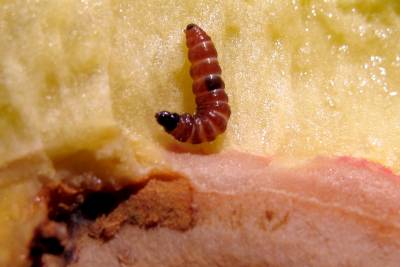
Peach Twig Borer
Importance as a Pest on Plum: low-moderate
Other Fruit Hosts: apricot, nectarine, and peach
General Info: In spring, chocolate brown larvae emerge from overwintering sites on the limbs of trees and then tunnel into succulent shoot tips. Infested twigs die back and small masses of gum exude from tunnel openings. In summer, a second generation of these “worms” enters fruit when succulent shoot growth has ceased. Larvae typically enter fruit near the stem end. In backyard orchards, injury may not be severe enough to require treatment every year.
Symptoms:
- Holes in fruit with sawdust-like frass
- New shoots with the top 1-inch with wilted foliage
Management: Peach twig borer activity is determined by seasonal temperatures, and the timing of activity varies from year to year. To find out when peach twig borer is active in your area of the state, and for spray recommendations, contact your local county Extension agriculture agent or subscribe to the USU IPM Tree Fruit Advisory. Conventional insecticide options include products containing a pyrethroid (ingredients ending in “thrin”), carbaryl, or malathion, and organic options include products containing spinosad or Bt (Bacillus thuringiensis).
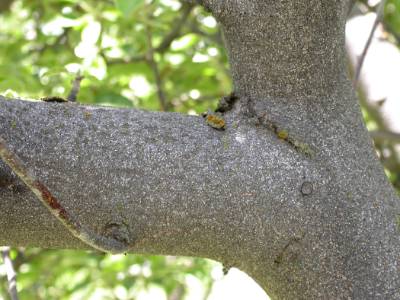
San Jose Scale
Importance as a Pest on Plum: low-moderate
Other Fruit Hosts: apple and stone fruit trees
General Info: San Jose scale is the most common scale insect to attack plum. Scales will feed on bark and small twigs. The soft body of the insect is hidden underneath an armored shield. Females produce young that crawl from under the mother scale before settling to feed. The “crawlers” are active in late spring.
Symptoms:
- Limbs encrusted with small, circular, black and gray armored scales (shown at right)
- Reduced tree vigor
Management: A 2% oil application during leaf expansion will kill overwintering immature scales, but not adult scales. Adults are difficult to kill, but die after their offspring (crawlers) emerge. To kill crawlers, apply bifenthrin or carbaryl in early June.
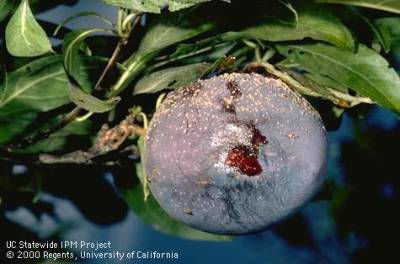
Speckled Green Fruitworm
Importance as a Pest on Plum: low
Other Fruit Hosts: apple, cherry, and pear
General Info: In Utah, the speckled green fruitworm is sometimes a pest of fruit trees for approximately 6 weeks in spring. There is one generation per year. The larvae hatch in spring and begin feeding on new leaves, flowers, and young fruit. Heavy feeding can cause localized defoliation of a tree canopy. The larvae can be detected by shaking branches over a tray.
Symptoms:
- Chewed leaves
- Early fruit drop
- Scarred fruit
Management: A single application of an organic insecticide containing Bt (Bacillus thuringiensis) or spinosad, in spring after fruit starts forming, is very effective.

Western Flower Thrips
Importance as a Pest on Plum: low
Other Fruit Hosts: apple, nectarine, and peach
General Info: Thrips are minute, thin insects that feed within the flowers and on young fruit. They are primarily a problem of plums at bloom. This early feeding results in scarred fruit.
Symptoms:
- Fruit scarring
- Deformed fruit
Management: Only an insecticide will prevent this injury. Spinosad can be applied when petals drop from flowers and at dawn or dusk (when bees are not foraging).





